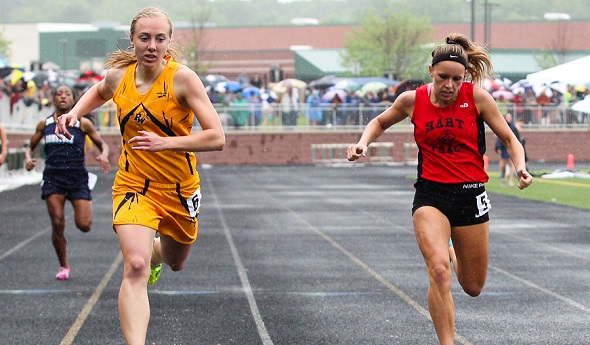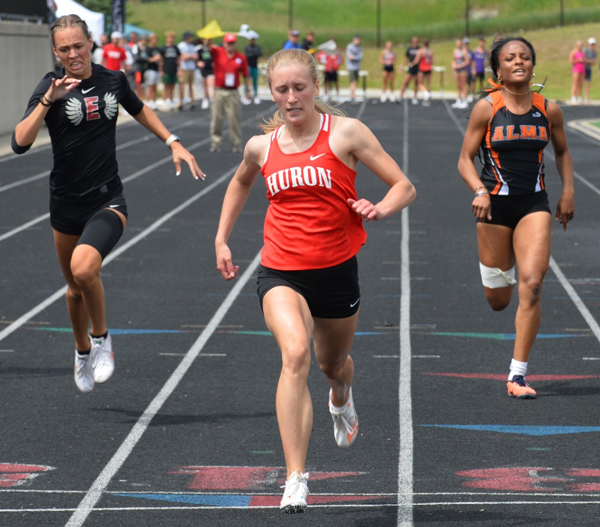
Wirth Shows Worth Again for D3 Power
June 2, 2016
By Dean Holzwarth
Special for Second Half
WESTPHALIA – This past March, fewer than 2 minutes remained in Pewamo-Westphalia's Class C Regional Semifinal basketball loss to Ypsilanti Arbor Prep when junior Brenna Wirth heard a pop in her right ankle.
 She fell to the floor in pain, unaware if her upcoming track and field season would be in jeopardy.
She fell to the floor in pain, unaware if her upcoming track and field season would be in jeopardy.
“That was one of my main concerns when it happened because I didn’t know how bad it was at first,” Wirth said. “It hurt a lot, and I heard a pop when it happened. I think I came down on a girl’s ankle and I was pretty worried.”
Wirth’s anxiety was eased by the good news that awaited her after the game. It turned out to be only a badly sprained ankle. Nothing worse.
“I got lucky I guess,” Wirth said. “But it has motivated me to push myself a little harder to get back to where I want to be.”
Wirth, one of the elite sprinters in Lower Peninsula Division 3, has fully recovered from the injury and is expected to compete in Saturday’s MHSAA Track & Field Finals at Comstock Park High School.
The Pirates have won two MHSAA girls track and field championships over the past three years and will look to go back-to-back Saturday.
Wirth will be an important component in their quest.
“We have a lot of depth, and she is part of that,” P-W track and field coach Scott Werner said. “One of the first pieces we look at is where we can utilize Brenna, and then we build around her to maximize our team points.”
She is thankful the ankle injury didn’t set her back longer than a few weeks.
“It healed a lot faster than I thought it would,” Wirth said. “I slowly began walking on it again, and I went from there. I’m excited for this weekend, and I think our team has a good shot this year again.”
Werner said Wirth has made the necessary strides to make a speedy comeback.
“I consider her healthy now,” he said. “She has been building up and feeling as good as she has the whole year. Things are starting to come together, and we hope we can peak this Saturday and finish things off right.”
Wirth will take part in the 200 and 400, as well as join her teammates as a member of the top-ranked 400 and 800 relay teams.
She won both individual events at last week’s Regional and is considered among the favorites to take home an individual title Saturday.
Wirth has plenty of motivation, especially in the 400, which is her signature event. She placed runner-up at the Finals as a freshman and sophomore.
“I’ve gotten so close in the 400 these past few years, so I’m hoping this is the year,” Wirth said. “I just want to give it my best effort. I’ve worked hard all season to get to this point, so I’m just hoping to run fast for the team. My team is the end goal, everything for them.”
Wirth’s work ethic separates her from other athletes, and it has helped propel her to success on the track and in other sports.
She also competes on the cross country team and delivered a new personal record at the Finals last fall.
“She is just a real athletic kid, and every sport that she is part of she is very good at,” Werner said. “She is such a hard worker, and where she excels at the most the past few years is the 400. That’s a type of race that you have to grind through, and she’s really strong mentally. She can go in and fight through and do her thing.”
Wirth will run Saturday without her older sister, Marissa, by her side. The two shared the track and past two seasons before Marissa graduated.
They drove each other to compete at the highest level.
“We ran on the same relays, and at times I had to run against her,” Wirth said. “It’s a lot different this year, and I really do miss her. She really pushed me, and I think I helped push her a lot. We kept each other going.”
Wirth made her presence known early on in her high school career, emerging as one of the top sprinters on a team chock-full of talented runners.
“She immediately came in and was among our best sprinters of what I would consider a pretty strong sprint program the past few years,” Werner said. “She was an instant-impact-type kid. She has a real positive attitude and sets a really great tone. She’s a good leader, and she’s a part of the strong culture that we have here.”
PHOTO: Pewamo-Westphalia's Brenna Wirth (left) crosses just before Hart's Jennie Gottardo to finish second in the 400 at last season's Lower Peninsula Division 3 Final. (Photo by Jamie Geysbeek/RunMichigan.com.)

Multi-Sprint Champ Racing to Finish Huron Career Ahead of the Rest Again
By
Keith Dunlap
Special for MHSAA.com
May 25, 2023
NEW BOSTON – If there was one thing Elizabeth Anderson took pride in elementary school, it was simply showing that she could outrun everyone in sight.
 In fact, Anderson has an explanation for all the success she had in those playground races.
In fact, Anderson has an explanation for all the success she had in those playground races.
“Dominance when you are in elementary school,” Anderson quipped. “I don’t think I ever had a nickname. I just think everyone knew I was fast.”
Years later, pretty much everyone who follows track & field in the state of Michigan can attest to that.
A senior for New Boston Huron, Anderson has been faster than most other competitors in the state during her three-year high school career (with her freshman season in 2020 canceled due to COVID-19).
Last year, Anderson won titles at the Lower Peninsula Division 2 Finals in the 200-meter (25.07) and 400-meter (56.28) dashes, and was runner-up in the 100-meter dash (12.23).
Often, top sprinters focus on one or two of those three races. But Anderson is certainly a different breed of sprinter because she does all three.
In fact, she holds school records in all three of those events, and if all that weren’t enough, Anderson is a part of all three sprint relay teams.
“It is hard to give her events off,” said New Boston Huron head girls track coach Danielle Lobato.
Despite the different styles the 100, 200 and 400-meter dashes present, Anderson said there usually isn’t much adjusting when she goes from one of those races to another.
 The strategy is simply, “Let’s beat the other girls to the finish line.”
The strategy is simply, “Let’s beat the other girls to the finish line.”
“I don’t really go into each race changing up how I would run,” she said.
While enjoying and succeeding in all three races, Anderson said she actually does have a favorite among them.
“I would say the 400 is probably my favorite,” she said. “Even though it hurts, it’s satisfying to see how much you can get your time down in the 400 compared to any other race.”
Anderson said she started running track in sixth grade, but really got serious about it during the summer after her sophomore season, when she was invited to run for a local club.
Eventually, that led to her competing over the winter in indoor events.
She lived and breathed track so much that last fall, she decided to not run cross country so she could focus on a weightlifting regimen aimed at developing more leg strength.
“Once I started doing summer track, I realized I wanted to be doing this all the time,” she said.
Lobato said oftentimes in practice, Anderson is a de facto coach, given there is no better person she can think of for the younger runners on the team to learn from.
“I can’t always demonstrate these things I’m trying to teach,” she said. “You get to see it in real life (from Anderson), not in a YouTube video.”
After winning the 100, 200 and 400-meter dashes at her Regional meet last week, Anderson has her sights set on achieving the same trifecta of titles at next Saturday’s Finals in Grand Rapids.
Anderson has signed to run track at Michigan State, but has been plenty motivated to keep producing this spring in her final high school season.
“I’m really looking to defend my titles,” she said. “That is what is really motivating me to keep going. I want to keep in shape for the college season. I don’t want to lose any of the progress I have made. Ultimately, I just love running track.”
And since elementary school, Anderson has loved — and succeeded in — outrunning everyone else to the finish line.
“We knew we were getting something special,” Lobato said of when Anderson arrived in high school. “But you never expect this. All that she has accomplished is amazing.”
 Keith Dunlap has served in Detroit-area sports media for more than two decades, including as a sportswriter at the Oakland Press from 2001-16 primarily covering high school sports but also college and professional teams. His bylines also have appeared in USA Today, the Washington Post, the Detroit Free Press, the Houston Chronicle and the Boston Globe. He served as the administrator for the Oakland Activities Association’s website from 2017-2020. Contact him at [email protected] with story ideas for Oakland, Macomb and Wayne counties
Keith Dunlap has served in Detroit-area sports media for more than two decades, including as a sportswriter at the Oakland Press from 2001-16 primarily covering high school sports but also college and professional teams. His bylines also have appeared in USA Today, the Washington Post, the Detroit Free Press, the Houston Chronicle and the Boston Globe. He served as the administrator for the Oakland Activities Association’s website from 2017-2020. Contact him at [email protected] with story ideas for Oakland, Macomb and Wayne counties
PHOTOS (Top) New Boston Huron's Elizabeth Anderson clears the finish line during last season's LPD2 400 race. (Middle) Anderson, middle, outpaces the field to also win the 200. (Click for more from RunMichigan.com.)

